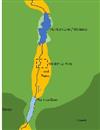|
|
|
Analytical Flow Modeling - Unsteady
|
|
|

|
|
Groundwater Mounding and Baseflow Regression Dynamics
Intermediate to Advanced - Application of analytical solutions. Background: Consider the mounding of groundwater between two streams draining an unconfined aquifer (see Figure 1). A common practice is to analyze the flow in the system by assuming predominantly horizontal flow in the aquifer. The analysis may be further simplified by assuming that the change of the saturated thickness along the direction of flow (x-direction) of the aquifer is small compared to the average saturated thickness.
(Analytical Flow Modeling - Unsteady- 10)
|
|

|
|
Bank Sstorage and Flux Dynamics
Bank storage is water stored in river bank sediments. At times of high water flow in rivers, water may flow laterally into the stream bank sediments adjacent to the river. This “stored” water may flow slowly back into the river or be utilized by wells. Watch the related videos, answer short questions, and re-create the animations/models using MAGNET.
(Analytical Flow Modeling - Unsteady- 10)
|
|

|
|
Transient Aquifer Dynamics In Response To Tidal River Fluctuation
Waves in surface water bodies will propagte into aquifer that are in direct communication with them. Develop a MAGNET model to simulate wave propagation, and compare your results with the analytical solution. Also perform a visual sensitivity analysis of your MAGNET model with respect to storage coefficient, hydraulic conductivity, and frequency of fluctuation.
(Analytical Flow Modeling - Unsteady- 10)
|
|

|
|
Artificial recharge through wells
Artificial recharge is possible through injection wells after rainfall events for groundwater storage and recovery purposes. Use MAGNET to assess the effectiveness of an example Aquifer Storage and Recovery (ASR) project. In particular, simulate and compare the aquifer drawdown in the dry season i) with artificial well injection during the wet season; and ii) without artificial well injection during the wet season.
(Analytical Flow Modeling - Unsteady- 10)
|
|

|
|
Dam break and basement flooding dispute
Those Dam Guys LLC was contracted to take on an controversial project - removing the Plankton Dam along an otherwise picturesque stretch of the Plankton River. While they were using a control structure to drawdown the water level in the reservoir, the system failed, causing the downstream river levels to rise by 4m. Several citizens sued Those Dam Guys, claiming their basements were damaged because of the rising groundwater levels caused by high river levels after the dam break. The consultants argued that the basement flooding due was to the inherent surface drainage issues in the clay rich floodplain area, and had nothing to do with river level rise after the dam break. You be the judge..is Those Dam Guys LLC responsible??
(Analytical Flow Modeling - Unsteady- 10)
|
|

|
|
Gradual Linear Change at the Boundary
Simulate an unconfined aquifer under direct influence of a large perennial river. Water table fluctuations are monitored by two wells placed along an average streamline of groundwater flow. The hydrographs show two episodes of a gradual increase in the water table which are consequences of the following:
1) a change in the river stage during a period without precipitation in the study area (first episode), and 2) a change in the river stage accompanied with infiltration from precipitation during a two-week period with frequent rains (second episode). Also perform sensitivity analysis and estimate aquifer properties and the infiltration rate.
(Analytical Flow Modeling - Unsteady- 10)
|
|

|
|
Stream Aquifer Interaction
(Lesson - Under Development) Beginner. This exercise explores the impact of stream stage fluctuations on adjacent aquifer systems (both unconfined and confined). Part I involves qualitatively describing the key parameters and relationships controlling groundwater response to stream fluctuations through the analysis of (vertical cross-section) profile models. Part II presents the mathematical framework of stream-aquifer interaction, giving students the opportunity to quantify groundwater dynamics and infer aquifer properties from observational data.
(Analytical Flow Modeling - Unsteady- 10)
|
|
|
|